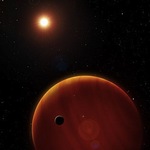Two talks for the APS Prairie Meeting
| Date/Time: | Friday, 04 Nov 2011 from 4:10 pm to 5:00 pm |
|---|---|
| Location: | Room 3 |
| Phone: | 515-294-2958 |
| Channel: | College of Liberal Arts and Sciences |
| Actions: | Download iCal/vCal | Email Reminder |
Alan Hulsebus: Mid-Infrared Substellar Companion Mass Limits for Nearby Planet-Host Stars
The sensitivity of the Infrared Array Camera on NASA's Spitzer Space Telescope at 4.5 um provides the ability to use direct imaging to capture light from brown dwarfs expected to have peak emission in this band. Using PSF subtraction techniques, we can detect sources with better than 1E+4 contrast at separations as close as 12 arcseconds. Potential substellar companions can be identified from their characteristically red colors between the 3.6 and 4.5 um photometric bands. In a sample of 14 nearby stars already found to have planetary companions from radial velocity searches, we found no sources consistent with substellar-mass companion colors within 20 arcseconds of the stars. This corresponds to 4.5 um upper limits for objects of 5 Jupiter masses at 1 Gyr age and 10 pc distance. I will present a description of the point spread function and artifact subtraction process necessary to achieve this result.
Sarah Willis: Infrared Observations of Massive Star Forming Regions
We have observed NGC 6334 with NASA's Spitzer Space Telescope, using
the IRAC infrared imager at wavelengths of 3.6 - 8.0 microns, and
NEWFIRM, a ground based near-infrared imager at wavelengths of 1.1 -
2.4 microns. NGC 6334 is a giant molecular cloud with a complex
history of star formation located approximately 1.6 kpc away in the
plane of the Milky Way Galaxy. NGC 6334's high cloud mass (1E+5 Mo)
and bright far-infrared luminosity identify it as a local analog to
the unresolved sites of star formation found in other galaxies.
Observing high mass Galactic regions such as NGC 6334 will provide the
missing link necessary to match empirical relations between the
efficiency / rate of star formation and the global properties of the
molecular cloud derived from nearby, lower mass star forming regions
to results from external galaxies. Our preliminary results reveal that
NGC 6334 contains several hundred Class I YSOs and several thousand
Class II YSOs concentrated at multiple sites of star formation across
the molecular cloud complex.


